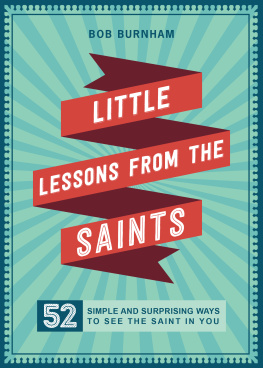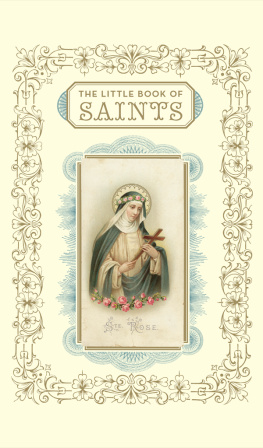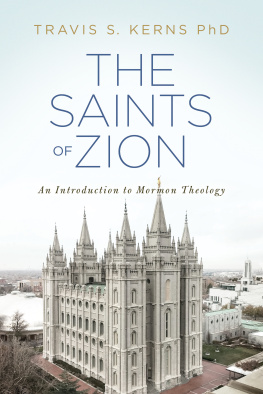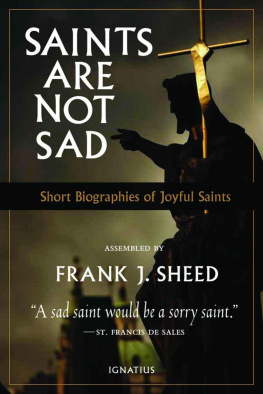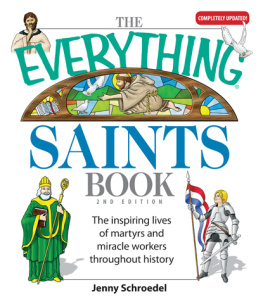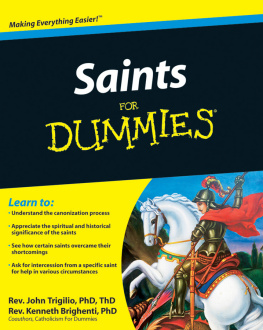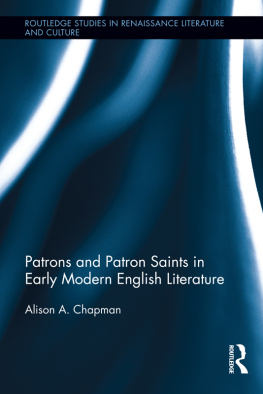Saints are the heroes and heroines of the Church those deemed to have lived such good lives, or endured death so perfectly, as to be guaranteed an afterlife in Paradise. The cult of the saints arises because of their aura, the sense that they hold a golden key to the puzzle of existence. Having the ear of God, they also act as advocates, pleading for divine help on our behalf. In medieval times the saints were a popular passion. Akin to todays celebrities, they were continually emulated and discussed by their fans, while pilgrimages to their shrines were the forerunners of modern mass-tourism. Images and relics of saints were highly prized, while books of their lives were the first truly popular best-sellers.
This book aims to provide a worthwhile selection from the thousands of saints in the calendar. People in all walks of life are represented, from a Holy Roman Emperor (Henry II) to the peasant girl Maria Goretti; from Nicholas Owen, a carpenter who made priest holes, to the politician and power-broker Sir Thomas More; from Ugandan saint Joseph Mkasa to Maximilian Kolbe, a martyr of Auschwitz. There are clues in these lives to the causes for which each saint may be invoked, some obvious, others more obscure. Enquire within if you want to know why Clare is the patron of television and Jude a specialist in desperate causes.
How is a person raised to sainthood? In the early Church, canonisation did not exist. A saint simply emerged by popular acclaim, particularly if there were miracles around the tomb or relics. But eventually the Catholic Church began to handle matters more judiciously, with what was effectively a legal trial in which a postulator and a devils advocate were appointed to argue the case for and against a particular candidate. A three-stage process is followed today. First the candidate must be formally accepted as a Servus Dei (Servant of God). This, after exhaustive investigation, is followed by beatification, in which the candidate is given the title Blessed. The final stage, which may not be reached for decades, even centuries, brings full canonisation in Rome.
The official source for the lives of all saints in the Catholic Church is the Acta Sanctorum, while the most colourful (and unreliable) is Jacobus de Voragines The Golden Legend, possibly the most widely read book in medieval Europe. This work is sometimes mentioned under Sources. Some near-contemporary biographies have also been mentioned.
THE SAINTS
Abbot
111067
Aelreds father and grandfather were both priests of Hexham, Northumbria, at a time before clergy were invariably celibate. As a teenager he served King David I in Scotland and, by the age of 24, he was Edinburgh Castles head steward. But, hearing that a group of eleven men had founded Britains first Cistercian monastery in Yorkshire, Aelred returned to England to join them. Elected abbot in 1147, he made Rievaulx one of the most powerful monasteries in Britain, and the original eleven swelled to a community of 650. Aelred upheld its standards by exercising uncommon gentleness and good sense. He travelled and wrote widely, especially on the spiritual value of common friendship. He died at Rievaulx, in an outhouse next to the infirmary. The monastic ruins are among the most romantically situated in Britain.
Feast: 3 February
Shrine: Rievaulx Abbey, near Helmsley, North Yorkshire
Writings: sermons, prayers, letters and the books On Spiritual Friendship and The Mirror of Charity
Virgin and Martyr
d. 3rd century. Canonised by early tradition

Few martyrs have been subjected to more graphically sexual tortures than Agatha. Born to wealthy Christian parents below Sicilys Mount Etna, she was a beautiful girl dedicated to virginity. After rejecting the amorous attentions of an official, Quintinian, she was confined in a brothel where her purity was miraculously preserved. In fury, Quintinian prosecuted her as a Christian and she was condemned to have her breasts torn away by pincers. These wounds were healed in a vision of St Peter, whereupon Agatha was dragged across burning coals until she died. These salacious details made her a favourite subject in art, often with her amputated breasts displayed on a plate. The similarity between these and loaves is said to have resulted in the blessing of bread on her feast day.
Feast: 5 February
Patron of bell foundries, nurses, Sicily, Malta
Causes: earthquakes, volcanic eruptions, fire, the protection of Sicily
Symbols in art: excised breasts on chafing dish, pincers, burning torch
Source:The Golden Legend
Virgin and Martyr
d. c.304

Agnes was born in Rome during Emperor Diocletians persecution of Christians. As with Agatha, she was a Christian girl who, at 12 or 13, refused to yield her virginity to an important pagan suitor. She was paraded nude through the streets to a brothel and, later, put to death by being stabbed in the throat, appearing afterwards to her parents with a lamb, symbol of youth and purity. At the monastery of St Agnes in Rome lambs are blessed each year, their wool dedicated to the weaving of papal vestments. Agness cult grew after her death and she is one of the earliest saints of her class to be venerated. Her own foster sister St Emerentiana was stoned to death while praying at Agness tomb.
Feast: 21 January
Patron of young girls, gardeners
Cause: charitable work
Shrines: a church raised above her tomb in the Via Nomentana, Rome, c.350; modern Rome has St Agnes- Without-the-Walls
Symbols in art: lamb, sword, palm
Source:The Golden Legend

A 15th-century representation of St Agnes with the Lamb of Christ, the symbol in art with which she is associated (Dagli Orti)
Abbot and Missionary
d. 651

An Irishman, Aidan was a monk of lona sent to evangelise Northumbria. He founded the celebrated abbey at Lindisfarne, from where, with the support of the local Christian king, Oswald, he travelled much, preaching and performing miracles and spreading the Christian message in the Celtic, as distinct from the Roman, style. Bede, by whose time the lonan Celtic forms were regarded as obsolete, nevertheless had high praise for Aidans goodness, gentleness and moderation.
Feast: 31 August
Shrine: Lindisfarne
Symbols in art: stag, torch
Source: Bedes History of England
Martyr
d. c.209
Regarded as the earliest English martyr, Albans dates are uncertain. He was a pagan Roman officer at Verulamium who, during an outbreak of anti-Christian persecution, sheltered a priest on the run and was converted by him. With the search party at the door, he changed clothes with the priest and was himself caught and beheaded. On the way to his death he is said to have parted the waters of the River Colne to enable a large crowd of onlookers to reach the execution place, Holmhurst Hill, which became the site of his shrine. It is now the cathedral of St Albans.







